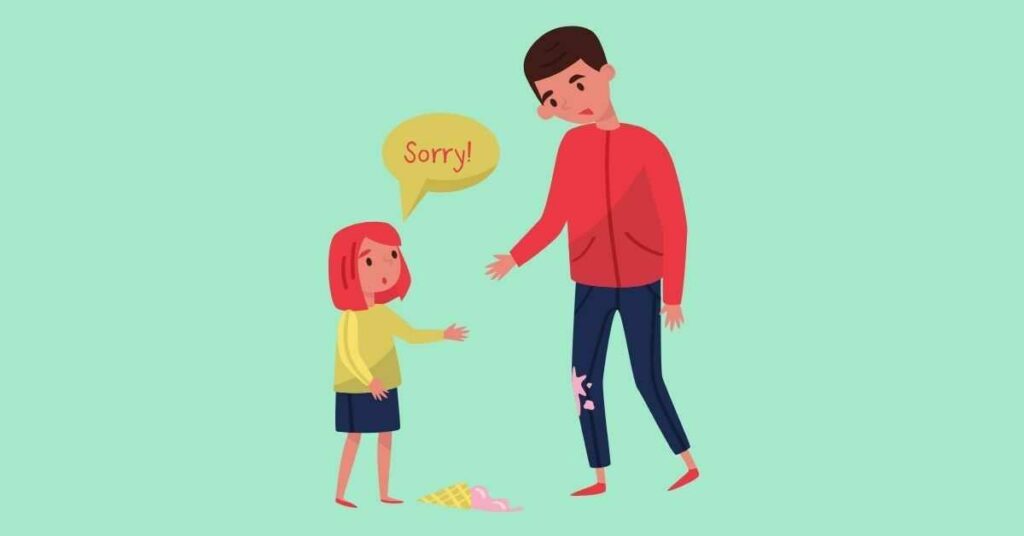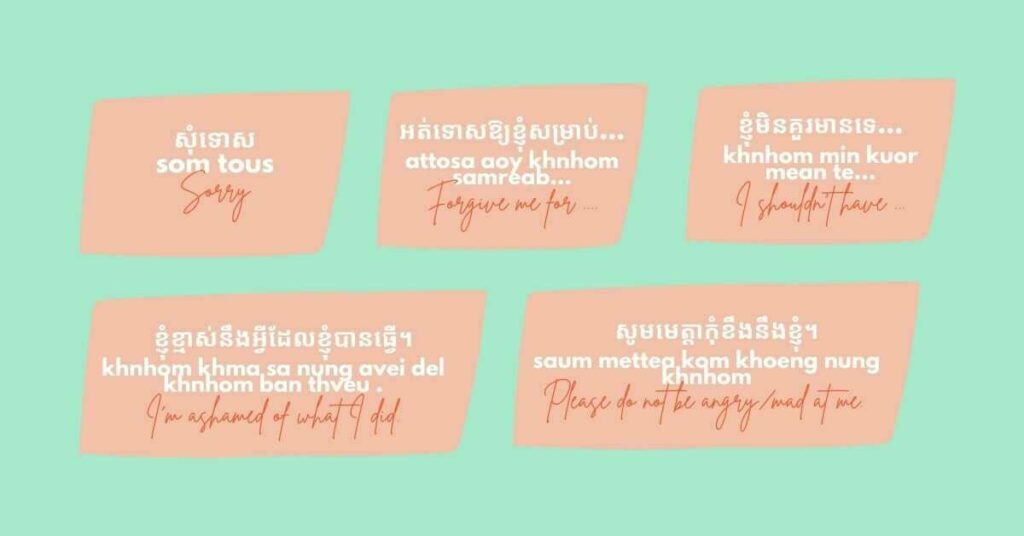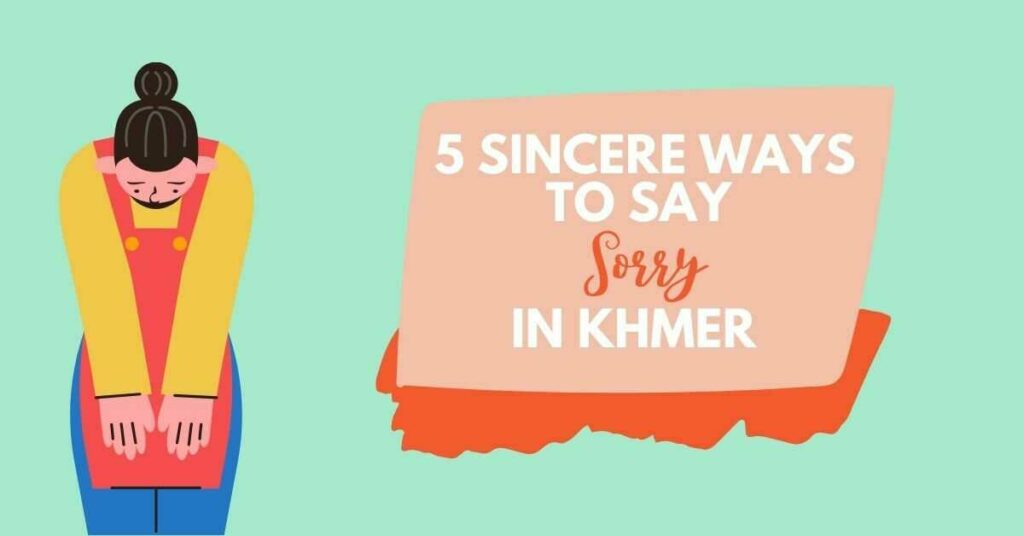In 1998, two top leaders of Khmer Rouge said សុំទោស / sŏm toŭs (sorry in Khmer ) for the reign of terror that cost the lives of almost 1.7 million people. This apology appeared to be half-hearted and with little remorse, according to an article from Washington Post. We all know the History of Cambodia under the Khmer Rouge that is why saying សុំទោស / sŏm toŭs (sorry in Khmer the language) is a massive deal for Cambodians. So, for this blog, we will learn how to say sorry in Khmer.
The Power Of Saying Sorry

People learn to apologize since they were young. As children, we were told to apologize if we did something wrong or hurt someone. But growing older, apologizing becomes more complicated because we already have different views about saying sorry. No matter how complicated it is, we cannot deny the power of apologizing and saying sorry. Here are the positive outcomes of apologizing and saying sorry:
- shows humility
- re-establishes dignity for those you hurt
- repairs relationship
- lets people know that you are not proud of what you did wrong
- can help ease the pain and tension
- opens the way to forgiveness
There are lots of good outcomes you can get from a sincere apology. Please remember that apologizing or saying sorry is the first step towards healing. Yes, saying sorry may not solve every problem, but showing humility will not harm you.
How Do You Say Sorry In Khmer?

Khmer, also known as the Cambodian language, is widely spoken in Cambodia. This is the official language used by most of the locals. Although some locals, especially the younger generations, speak English, it is still nice to learn essential words you can use while you are in their country. One of those words is sorry. There are different ways to say sorry in Khmer; let us learn some!
1. សុំទោស (som tous)
English Translation: Sorry/ Excuse me
This is the basic and most common way to say sorry in Khmer. But do not get confused because សុំទោស (sŏm toŭs) is also used to say excuse me in Khmer. This can be used in many situations, starting from simple ones like accidentally bumping into someone down to more complex problems. Learning this simple word in Khmer will save you in many situations, and most of all, it shows respect and politeness.
2. អត់ទោសឱ្យខ្ញុំសម្រាប់… (attosa aoy khnhom samreab…)
English Translation: Forgive me for …
If you were looking for other words to say sorry in Khmer, this is a good idea. Using this, you are not just saying sorry, but you are also asking for forgiveness. Remember, do not force anyone to forgive you. Everyone has their own pace in healing. Like the Cambodians who lost their loved ones during the Khmer Rouge regime, people will not always forgive them too easily.
3. ខ្ញុំខ្មាស់នឹងអ្វីដែលខ្ញុំបានធ្វើ។ (khnhom khma sa nung avei del khnhom ban thveu .)
English Translation: I’m ashamed of what I did.
Admitting that you are wrong and saying that you are not proud of it is another way of saying sorry. This lets people know that you are careful not to hurt anybody through your actions. Not being proud of what you did and promising you won’t repeat such behavior will focus on your better virtues rather than your mistake.
4. សូមមេត្តាកុំខឹងនឹងខ្ញុំ។ (saum mettea kom khoeng nung khnhom)
English Translation: Please do not be angry/mad at me.
This expression is not imperative as it may sound. You are not literally asking someone not to be mad at you; instead, it is a way of saying that you have reasons behind such behavior, and you are begging and hoping that the person will understand you. Even so, do not be offended if that person will still get mad at you. You actually did something wrong so, be patient about the decision.
5. ខ្ញុំមិនគួរមានទេ… (khnhom min kuor mean te…)
English Translation: I shouldn’t have …
There are times that you are decisive in making a decision that you forget it might hurt someone. After realizing your mistake, this is an excellent phrase to say sorry. This will let people know that you are aware of the things you should not have done. This will lessen the probability that you will do such a thing again.
How Do I Respond To Sorry?

If the situation is reversed and you receive an apology, how would you respond in Khmer? In the process of reconciliation, responding is really important. This will help you understand each other and make the situation better. Here are some ways how to respond to sorry in Khmer:
| Khmer | Pronunciation | English Translation |
| មិនអីទេ | min ei te | It’s fine/ok |
| វាកើតឡើង។ | vea kaetlaeng | It happens. |
| គ្មានបញ្ហា។ | kmean banhhea. | No problem. |
| កុំបារម្ភអំពីវា។ | com baromph ampi vea | Don’t worry about it. |
| អ្នកត្រូវបានលើកលែងទោស។ | anak trauv ban leuklengtosa | You are forgiven. |
Being forgiven is one of the greatest feelings in the world. Now that you have learned different ways to say sorry សុំទោស (som tous) in Khmer and the response, you should remember that the best apology is a behavior change. If you apologize and continue making the same mistake over and over again, it simply means that your apology is just empty words.
Learning to say sorry in Khmer is a nice gesture to show politeness and respect for their culture. As a foreigner, learning the single word sorry down to more complicated phrases will really show how sincere you are in apologizing.
Want To Learn More Khmer Words And Phrases?
After learning different ways to say sorry in Khmer, it is time to learn more new Khmer words and phrases through Ling App. You can search it online, or you can click the links found in this content. Through Ling App, you will have a meaningful, engaging, and convenient language learning experience. Interactive lessons, pictures, audio recordings, and even games are provided for you to learn.

Learning new languages is something that will last forever. You don’t know what doors might open when you learn to communicate with people from other countries. So, what are you waiting for? Start learning Khmer now!



































































